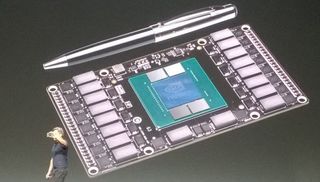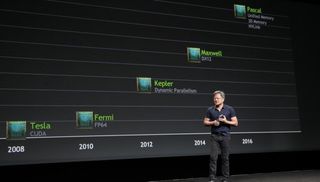Beyond Maxwell: Nvidia announce their next next-gen Pascal GPU

Nvidia's GPU Technology Conference keynote was full of announcements this week. In addition to revealing the $3000 Titan Z, CEO Jen-Hsun Huang updated Nvidia's graphics architecture roadmap with a first look at the Pascal GPU.
This is the graphics technology to come after the Maxwell architecture finished its run, and is due to appear in 2016. I'm not quite sure what happened to the Volta GPU architecture that was pegged for a post-Maxwell release as recently as CES in January, but that looks to have been delayed by a least two years, after Pascal.
Code-named after the scientist Blaise Pascal, the new GPU architecture will introduce three dimensional memory and a new interconnect, called NVLink, that is set to offer up between five and twelve times the bandwidth of the current PCIe connection.
That 3D memory, also known as stacked memory, means the VRAM will be stacked directly on top of the GPU itself. “We're going to, for the first time,” said Jen-Hsun, “build chips on top of other chips. We're going to pile heterogeneous chips—meaning different types of chips—on one wafer.”

They then punch tiny holes in the silicon to allow for connections to be made all the way through the DRAM stack and down into the GPU. “Together it forms an interface that delivers an unbelievable amount of bandwidth,” he continues. “A huge leap.”
Nvidia estimate we'll see a boost of between two and four times the memory bandwidth that's currently available. It also allows for 2.5 times the capacity and an impressive four times the energy efficiency of current GPUs.
The new NVLink interconnect that goes along with the new GPU design offers a huge uptick in PCIe bandwidth and increases the available bandwidth for multi-GPU arrays with Pascal GPUs too. That should enable more advanced, possibly linear, scaling as you add more and more GPUs to a machine.
PC Gamer Newsletter
Sign up to get the best content of the week, and great gaming deals, as picked by the editors.
Jen-Hsun Huang showed on-stage a development board with the Pascal GPU sat in the middle, calling it a “supercomputer the size of two credit cards.”
It's a tantalising glimpse into the future of Nvidia's GPUs, but regardless of the bandwidth numbers and the world-changing possibilities research with such cheap supercomputers could deliver, I just want to know how smoothly it's going to render Unreal Engine 4 at 4K.

There was conspicuously little talk about the 20nm Maxwell GPUs at the conference. We've already seen the mainstream release of the 28nm GM107 GPU in the GTX 750 and GTX 750 Ti, but what about the top-dog, high-end Maxwell? The dual-GPU GTX Titan Z still sports Kepler-based GK110 GPUs, is there a high-powered Maxwell card in the works?

Dave has been gaming since the days of Zaxxon and Lady Bug on the Colecovision, and code books for the Commodore Vic 20 (Death Race 2000!). He built his first gaming PC at the tender age of 16, and finally finished bug-fixing the Cyrix-based system around a year later. When he dropped it out of the window. He first started writing for Official PlayStation Magazine and Xbox World many decades ago, then moved onto PC Format full-time, then PC Gamer, TechRadar, and T3 among others. Now he's back, writing about the nightmarish graphics card market, CPUs with more cores than sense, gaming laptops hotter than the sun, and SSDs more capacious than a Cybertruck.
